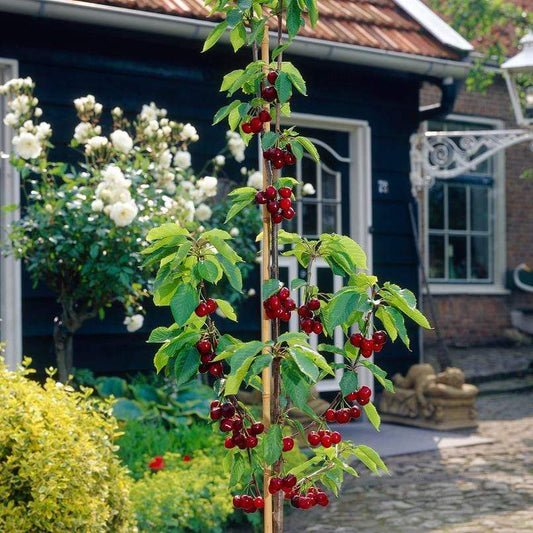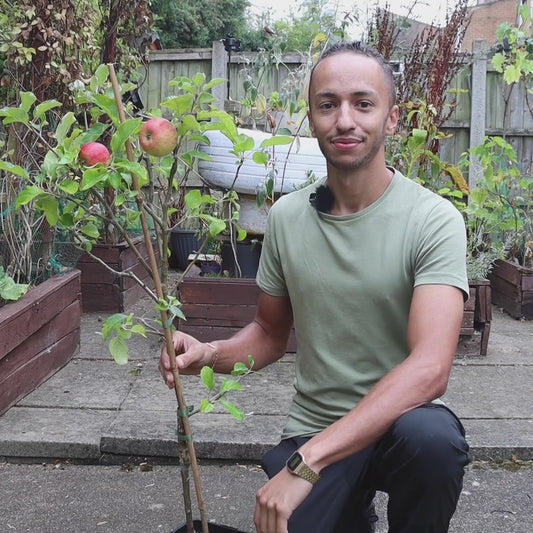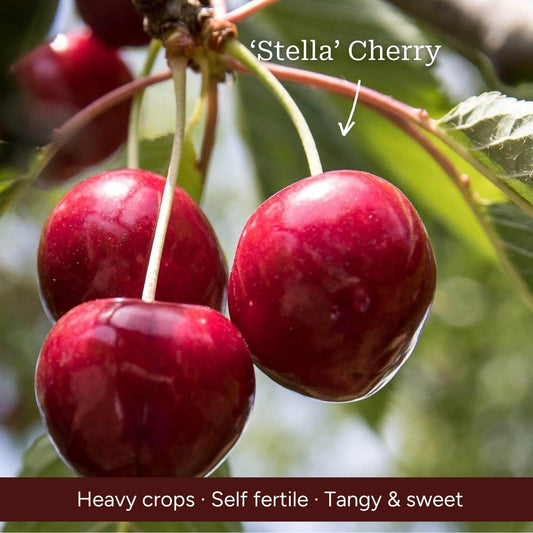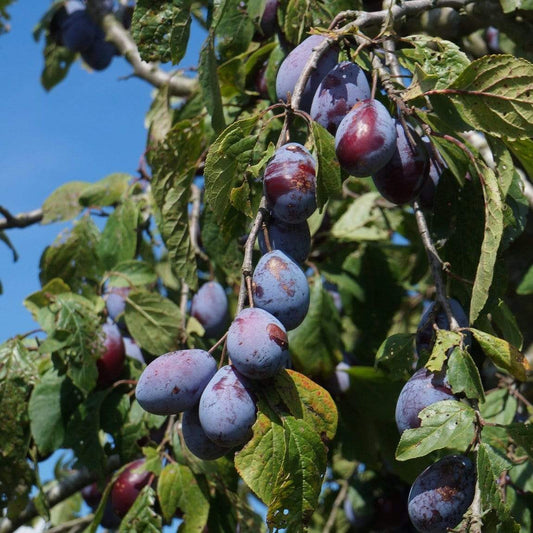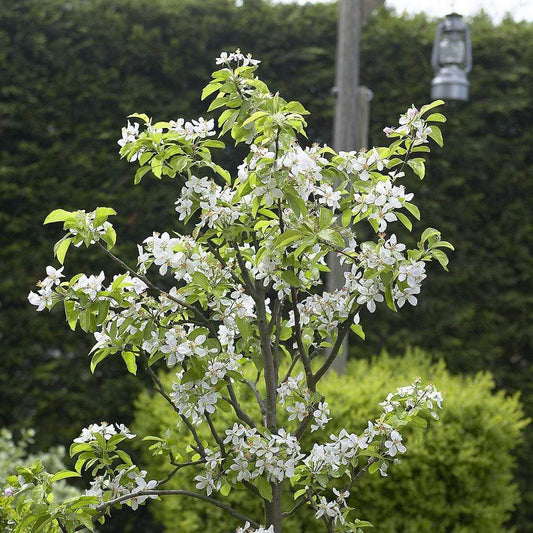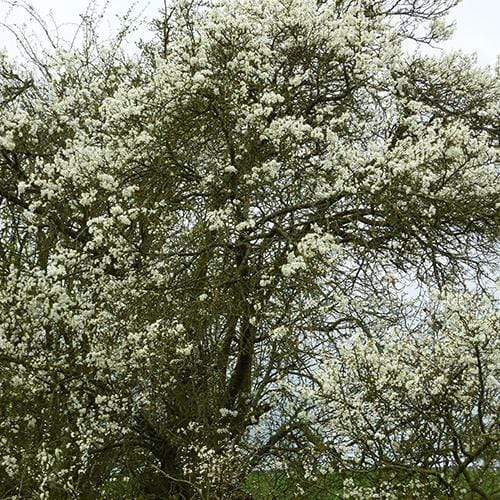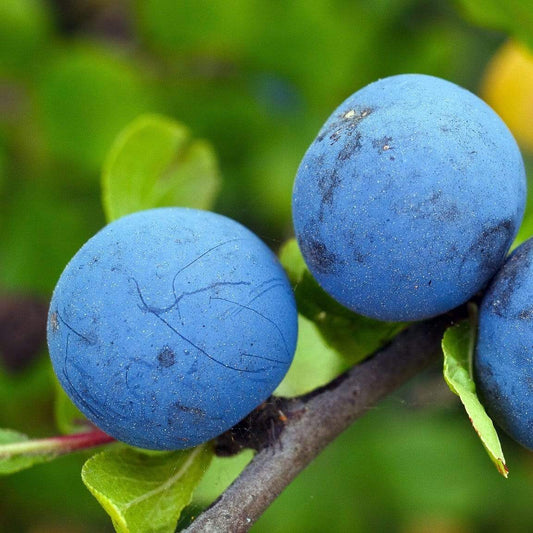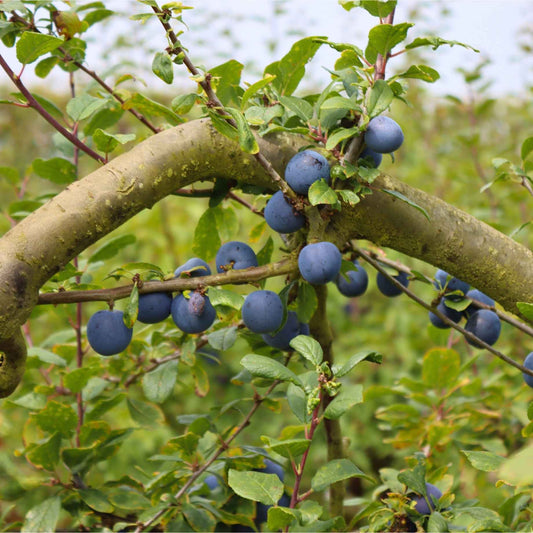Collection: Plum Trees
Our premium plum trees are perfect even for a beginner as they’re so reliable and heavy cropping. Damsons and gages are from the same family and are well worth adding to your home orchard. And naturally they’re all traditionally grown and hand-picked (literally) by our UK tree growers for their exceptional performance, so they’re guaranteed to produce the goods!
Need help picking?-
Regular price From £30Regular price
£45Sale price From £30'Victoria' Plum Tree
Plums fit for a queen
- The iconic plum with a superb flavour
- Damp, cold or partial shade? No problem
- Makes the perfect plum frangipane
- Harvest from late August onwards
5 options available
-
Regular price From £33Regular price
£45Sale price From £33'Opal' Plum Tree
As stunning as a precious stone
- Aromatic, juicy and flavourful
- Fast-growing and early-cropping
- Bite-sized fruit, makes a topnotch crumble
- Harvest from late July to early August
3 options available
-
Regular price From £30Regular price
£45Sale price From £30'Old Greengage' Plum Tree
An incredible heritage variety
- Rich, candy-sweet and tender
- A truly reliable cropper
- Superb eaten fresh
- Harvest from August
3 options available
-
Regular price From £32Regular price
£36Sale price From £32'Jubilee' Plum Tree
Even better than Victoria?
- A well-balanced, complex flavour profile
- Notably large fruits
- Makes a fabulous plum pie
- Harvest from mid-August
2 options available
-
Regular price From £80Regular price
£105Sale price From £80Mini Orchard Collection | Cherry, Pear & Plum Trees
Fruit all summer long
- Sweet and juicy fruits for eating and cooking
- Compact trees suitable for any size of garden
- Devour straight from the branches
- Harvest from July to October
1 option available
-
Regular price From £70Regular price
£97Sale price From £70The 3 Top Performing Fruit Trees to Grow in the UK | Apple, Pear & Plum
Three trees our growers swear by
- Bumper-cropping varieties
- Easy to grow and full of flavour
- Neat and compact trees for any garden
- Harvest from August to November
1 option available
-
Regular price From £40Regular price Sale price From £40
'Mirabelle De Nancy' Plum Tree
Versatile, French cherry plum
- Honeyed and highly moreish
- Easy to grow and loved by pollinators
- Make a classic Tarte aux Mirabelles
- Harvest from late August
2 options available
-
Regular price From £32Regular price
£45Sale price From £32'Oullins Golden Gage' Plum Tree
An easy-to-grow gage
- Sweet and aromatic
- A great choice for growing in cooler areas
- Pick and eat fresh or bake into a pie
- Harvest from the middle of August
1 option available
-
Regular price From £35Regular price Sale price From £35
Patio Plum Tree
Your fave varieties, kept small
- Expertly grown to keep nice and small
- Includes very hardy varieties
- Pick and eat fresh or make a sticky plum jam
- Sweet plums, sensational flowers
3 options available
-
Regular price £50Regular price Sale price £50
'Victoria' Patio Plum Tree
The UK's favourite - reliable, versatile and delicious!
- The iconic British plum tree with a superb flavour
- Damp, cold or partial shade? No problem
- Makes the perfect plum frangipane
- Expertly pruned patio tree perfect for pots
1 option available
-
Regular price From £80Regular price
£115Sale price From £80Classic British Orchard Collection | Apple, Cherry, Pear & Plum Trees
All the traditional UK faves!
- Iconic orchard varieties
- Features RHS award winners
- Well-suited to UK growing
- Produce a glut of delicious fruit
2 options available
-
Regular price From £45Regular price Sale price From £45
'Cambridge Gage' Plum Tree
One of the most popular gages
- Juicy and irresistable
- Any surplus will freeze well
- Superb in a greengage and pistachio cobbler
- Harvest from late August to early September
1 option available
-
Regular price From £34Regular price
£36Sale price From £34'Imperial Gage' Plum Tree
Superb taste, superb crop!
- Decadent and delectably sweet gages
- Well-suited to Northern climates
- Try making a greengage and vanilla tart
- Harvest from late August
2 options available
-
Regular price From £80Regular price
£95Sale price From £80Mini Orchard Collection | Apple, Pear & Plum
Grow your own thriving orchard!
- Juicy, sweet and intensely flavourful
- RHS award-winning varieties
- Eat fresh or use in scrummy desserts
- Harvest from July to November
1 option available
-
Regular price From £45Regular price Sale price From £45
'Guinevere' Plum Tree
A versatile, tasty new variety
- Sumptuously sweet plums
- Heavy cropper (and also self fertile)
- Eat fresh or cook up a crumble
- Harvest from mid-September (stores well)
1 option available
-
Regular price From £32Regular price Sale price From £32
'Czar' Plum Tree
Award-winning heavyweight
- A naturally sharper-tasting plum
- RHS Award of Garden Merit winner
- Make a plum sauce to serve with dumplings
- Harvest from early August to September
3 options available
-
Regular price From £100Regular price
£125Sale price From £1003 Super Easy to Grow Fruit Trees | Apple, Fig & Plum
Your orchard shortcut
- Sweet and juicy fruits
- Grow these compact trees in any size garden
- Eat fresh or make into jams
- Harvest from July to September
1 option available
-
Regular price From £35Regular price Sale price From £35
Cordon Plum Tree
Plenty of plums, minimal space
- Expertly grown in a columnar shape
- Includes reliably-cropping varieties
- Use to make syrups, jams and chutneys
- Honeyed plums, evocative flowers
3 options available
-
Regular price From £85Regular price
£105Sale price From £85Award-Winning Cordon Fruit Tree Collection | Apple, Pear & Plum
All the plaudits, half the space
- Columnar fruit trees that save on space
- Three RHS award-winning varieties
- Grow in pots and on balconies
- Create your own miniature orchard
1 option available
-
Regular price From £55Regular price
£67Sale price From £55Cordon Cherry and Plum Trees | Perfect Partners
Big flavours from limited spaces
- Columnar cordons are ideal for small gardens
- Two incredibly flavourful varieties
- Productive trees you can grow in pots
- Loved by pollinators
1 option available
-
Regular price From £52Regular price
£62Sale price From £52Cherry and Plum Trees | Perfect Partners
The ultimate stone fruit trees
- Grow your own delicious cherries and plums
- Flavourful, easy to grow and beautiful
- Eat fresh or use in baking and desserts
- RHS Plants for Pollinators
1 option available
-
Regular price From £32Regular price
£45Sale price From £32'Merryweather' Damson Tree
The largest damson variety
- A naturally tart, tangy flavour
- Grows well in cold and wet climates
- This iron-rich fruit makes great jam and wine
- Harvest from late August
Currently out of stock
-
Regular price From £30Regular price Sale price From £30
'Shropshire Prune' Damson Tree
Heavy-cropping, heritage damson
- Punchy, sharp taste that cooks down nicely
- Ideal for northern gardens
- Makes an outstanding damson crumble
- Harvest from early September
Currently out of stock
-
Regular price From £70Regular price
£105Sale price From £70Award Winning Patio Fruit Tree Collection | Cherry, Pear & Plum
Our growers' best picks for pots
- Grow your own fruit on a balcony or patio
- RHS Award of Garden Merit winners
- Easy care, heavy cropping and flavourful
- Harvest from July to October
Currently out of stock
-
Regular price From £30Regular price
£32Sale price From £30'Farleigh' Damson Tree
The best of all damsons?
- Rich and complex flavour
- A brilliant option for wall training
- Great for jam or damson vodka
- Harvest from late August to September
Currently out of stock
-
Regular price From £32Regular price
£50Sale price From £32'Lizzie' Plum Tree
Early-cropping, sweet, red plum
- The plum that tastes like pear drops
- The best plum tree for blossom
- Makes a fantastic plum tarte tatin
- Harvest from mid-July
Currently out of stock
-
Regular price From £30Regular price Sale price From £30
'Mirabelle Golden Sphere' Plum Tree
The belle of the... Sphere?
- Jammy with a touch of sharpness
- Neat and slender, perfect for smaller gardens
- Makes a beautiful Ukrainian plum pastry
- Harvest from late August
Currently out of stock
South Downs National Park
Meet Danielle
110 years' expertise free with every tree
Danielle's nursery has been growing trees in the South Downs National Park for over a century, and it shows. Dug up and sent straight to your garden at between 18-36 months old, their quality rootstocks, expert pruning and natural pest control mean that these traditionally field-grown trees are the hardiest you can get.
Need help picking?

Which plum tree?
Plums, gages and damsons are all members of the Prunus domestica family. Plums are large, soft fleshed and can be used for eating or cooking, depending on the variety. They’re easy to grow. Gages are smaller, rounder and sweeter for eating but need more sun than plums. Damsons are very easy to grow, have a tart flavour and are best for cooking and jam. Plums and gages will produce a crop within three years (1-2 years for smaller dwarfing varieties) while damsons may take between 3 and 5 - however it is worth the wait! Opal is great for a medium to large garden. If you have a small space or want to grow in a pot, choose a patio tree like Victoria. Here’s some more help with choosing.

What's the deal with rootstocks?
A tree’s rootstock determines how large it will grow, so it’s important to choose the right one for your space. Plum, damson or gage trees on Pixy rootstock grow to around 3m so they’re perfect for small to medium gardens. Trees on St Julien A (SJA) rootstocks are more vigorous, reaching heights of 4.5-5m.

Growers' tips
Plum trees are easy to grow. They’re happy in most well draining soils and prefer a sunny site. Prune them annually and they’ll reward you with many trouble free years. Many plum trees can fruit without another tree to pollinate them, but some need another plum nearby to do this for them. In theory this means that if you only plant one plum tree, it should be a self-fertile variety. However it’s very unlikely (unless you live in a remote area) that there won’t be another plum tree within a mile of you. If you do live in a remote area, self fertile varieties include Victoria Plum and Farleigh Damson.

Using your plums
Plums are delicious straight from the tree, but if we know plum trees (and we know plum trees), you’ll have more than you can eat! Make them into crumble, jam, chutney and tarts or check out our favourite recipes and ideas for preserving your bumper crop. Grown your own damsons? You have to try the classic gin…
Plum Tree FAQs
Where should I plant my plum tree?
It’s best to plant your plum tree in an area that gets at least 6 to 8 hours of direct sunlight each day. It’s also worth noting that frost can damage your trees if you plant them in low areas where there is a possibility of frost settling.
How long does it take a plum tree to produce fruit?
You may see your first plums 3 years after planting, but you should not expect substantial crops until the 4/5th year. Patience tastes like plums!
How do I care for a plum tree?
Grow plum trees in moist but well-drained soil in full sun. Bare root trees do not require regular watering, only during dry spells. On the other hand, container grown trees will need watering every other day for the first few months until their roots are established, slowly reducing this to twice a week until autumn. Don’t worry, there’s no need to feed! Plum trees get all the nutrients they need from the soil.
When should I plant a plum tree?
Bare root is best to plant late autumn to early spring when the trees are dormant, and potted trees are best in the summer.
Do I need to prune my plum tree?
We professionally prune our trees before dispatching them. This formative pruning can involve cutting the main leader, to stop the tree becoming 'leggy' and promote stronger, bushier growth.
Do I need two plum trees to produce fruit?
You may need two plum trees to produce fruit as many trees are not fully self-fertile. To ensure a successful crop on trees that are not self-fertile, you will need a compatible plum tree that flowers at the same time.
What are the best plum trees to grow in the UK?
Whatever your plum preference, there are plenty of varieties out there to suit all palates. Here are some of our favourites:
- Victoria Plum Tree - The UK's favourite - reliable, versatile and delicious!
- Opal Plum Tree - Superbly flavoured red dessert plum.
- Merryweather Damson Tree - The largest damson variety, great for cooking & jams.
- Old Greengage Plum Tree - Considered to have the best flavour of any plum or gage.
Happy plants make happy customers
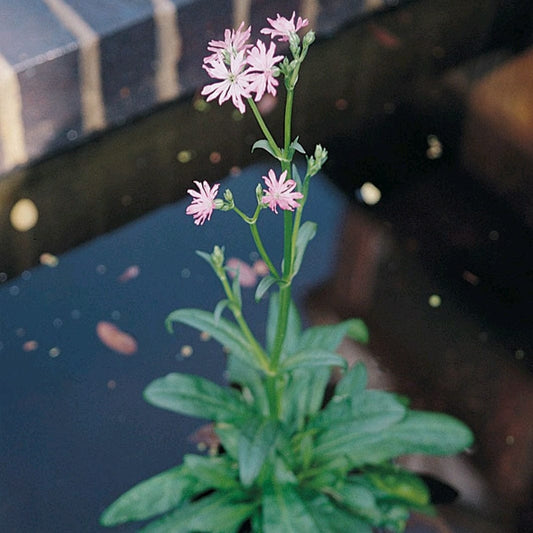
Plants arrived in great condition and very promptly. Well established - much better than the ones I got at my local garden centre.
Monica Spence
| 24 May
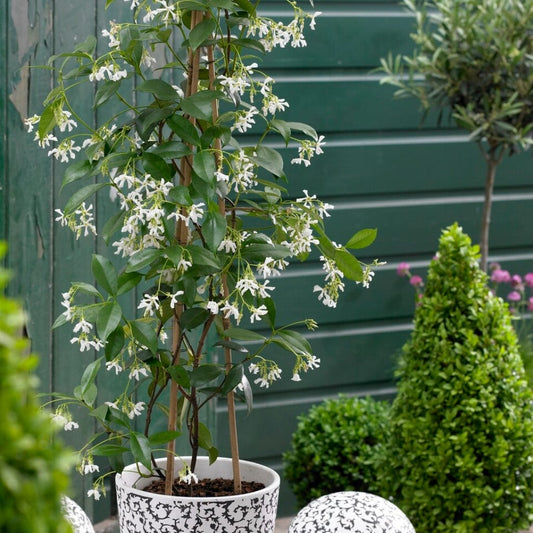
Yet again this company delivered good healthy plants, exactly as shown in photos, well packaged and within delivery time quoted. Recommend!
Jacqueline Burgess
| 2 Jun

I continue to be so impressed with Roots. Their customer care, knowledge of their subject: from planting hedges to pruning roses and more, has been a great support.
Judy Lane
| 23 Oct

The plant arrived looking vigorously healthy, which brings a smile to your face, extremely well protected in its packaging.
Martyn Hill
| 5 Jul

As a non-gardener, I found my whole experience brilliant. Great information & advice available on the website, great range of products & prices are brilliant.
John-Paul
| 22 May

Wonderful plants and great customer service... really surprised to find that the plants are better than those you would get at your local garden centre.
Gavin Wilcock
| 8 Nov
Fighting plastic waste
Delivering fresh from the nursery
Supporting UK growers











